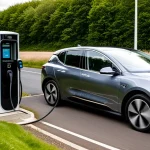Overview of the EV Charging Infrastructure Crisis in the UK
The electric vehicle (EV) charging infrastructure in the UK is lagging behind the rapid pace of EV adoption, creating a significant challenge for sustainable transportation goals. As more consumers embrace electric cars, the demand for accessible charging stations has skyrocketed. However, the current network is struggling to keep pace.
The UK market demand for EVs has surged, with record numbers of electric vehicles hitting the roads. Statistics indicate that while EV sales have increased exponentially, the development of charging stations has not matched this growth. This gap can lead to practical difficulties for EV owners, such as longer wait times and travel inconveniences when charging facilities are sparse or overused.
Additional reading : How are UK car manufacturers incorporating AI into their production processes?
Expanding the EV charging infrastructure is crucial for meeting sustainability targets. It not only supports the environmental benefits of transitioning to electric vehicles but also ensures that the technology remains a viable option for consumers. To drive the shift towards sustainable transport, there is an urgent need to bolster charging networks across the country, integrating them strategically into urban and rural areas alike.
Government Policies and Initiatives
The UK government has implemented several key policies aimed at accelerating the expansion of the EV charging infrastructure. These government policies focus on enhancing the accessibility and distribution of charging stations to meet the rising UK market demand for electric vehicles. Notable initiatives include grants and subsidies for businesses and local councils to install new charging points, effectively lowering the barriers to infrastructure development.
Also read : How Will Electric Vehicles Shape the Future of UK Manufacturing?
Recent EV infrastructure funding efforts have channeled significant resources into these endeavors. For instance, the On-Street Residential Chargepoint Scheme offers financial assistance to local authorities for the installation of on-street EV charging points, especially in areas lacking off-street parking. Additionally, the Rapid Charging Fund is part of the government’s Road to Zero strategy, aiming at ensuring that the UK’s motorway service areas have a comprehensive network of fast and reliable chargers.
The government has also set a timeline for implementation of these strategies, with 2030 as a pivotal year. By then, the ambition is to phase out the sale of new petrol and diesel cars, necessitating robust charging infrastructure to support this transition. Expected outcomes involve not only increased charger availability but also improved consumer confidence in adopting electric vehicles, contributing to broader sustainability objectives.
Public-Private Partnerships
Effective public-private partnerships are pivotal in expanding the EV charging infrastructure across the UK. These collaborative strategies harness the expertise and resources of private companies to tackle the rising UK market demand for electric vehicles. A prime example of such collaboration is the partnership between energy firms and local authorities, resulting in tailored EV charging solutions. These partnerships often facilitate innovative financing models to ease the initial financial burden, thereby encouraging more rapid infrastructure deployment.
Successful partnerships also include pilot programs that combine government policies with private sector innovation. One such initiative is the collaboration between Shell and UK Power Networks, which aims to develop pilot projects for ultra-fast charging hubs. These projects focus on optimizing infrastructure, ensuring that charging stations cater to both urban and rural areas efficiently.
However, these partnerships do face challenges, such as aligning objectives between diverse stakeholders and navigating regulatory hurdles. Despite these obstacles, the mutual benefits include accelerated EV infrastructure funding and the potential for achieving shared sustainability initiatives. When private companies bring technological advances and operational efficiency, and public entities offer policy support and incentives, the path to a comprehensive charging network becomes clearer.
Specific Charging Projects and Developments
With the UK market demand for electric vehicles rising, several major projects are underway to reinforce the charging stations network. These initiatives are not just about quantity; they aim to create a robust, efficient, and accessible EV charging infrastructure across the UK. For instance, there are substantial funding amounts being directed towards urban and rural developments to ensure widespread charging availability, ultimately supporting the country’s environmental and sustainability goals.
Recent infrastructure projects have received significant backing, such as the £300 million investment announced for the installation of thousands of chargers in both metropolitan and less developed areas. These charging initiatives are part of a broader strategy to avoid regional disparities in EV support, ensuring that no area is left behind in the transition to electric transportation.
The timeline for these advancements is ambitious, with critical projects expected to be completed by 2025. This accelerated approach underlines the urgency with which the UK is addressing its EV development challenges. The projected impacts include alleviating the current congestion at available charging points, reducing wait times, and increasing public confidence in adopting electric vehicles. These developments serve as a crucial step towards achieving comprehensive accessibility and reliability in the nation’s EV infrastructure.
Involvement of Key Stakeholders
The development and expansion of the EV charging infrastructure in the UK require active participation from a diverse range of stakeholders. Local councils and government agencies play a vital role in infrastructure expansion, offering essential support through policy frameworks and local governance to facilitate charger installations. Their involvement is critical in identifying locations, ensuring regulatory compliance, and securing funding for public charging stations.
The electric vehicle industry is a key contributor, with automakers investing in partnerships to create a charging network that aligns with their growth strategies. These companies often collaborate with charging network providers to develop cutting-edge technologies that enhance the efficiency and user experience of EV charging.
Additionally, the energy sector contributes by adapting grid capabilities and exploring renewable energy sources to power these charging stations sustainably. Their expertise in energy management is crucial for integrating charging solutions that meet increasing demand without compromising network stability.
Community organizations are also crucial stakeholders, providing insights into local needs and preferences. Their engagement ensures that charger locations are accessible and beneficial to residents. By working together, stakeholders from various sectors can create a coherent and resilient infrastructure that supports EV adoption on a national scale.
Comparing the UK’s EV Charging Infrastructure to Other Countries
As the UK market demand for electric vehicles (EV) rises, it becomes crucial to evaluate how the UK stacks up against other leading nations in terms of EV charging infrastructure. Globally, countries like Norway, the Netherlands, and China are at the forefront of EV adoption and have developed comprehensive global charging solutions that ensure seamless transition to electric transportation. Exploring these international examples provides valuable insights for the UK.
Norway, for instance, boasts one of the highest EV adoption rates globally, supported by a robust network of charging points relative to its population size. Their use of strong governmental incentives and commitment to renewable energy sources places them as a benchmark for sustainability initiatives. The Netherlands, known for its dense network of public chargers, exemplifies how strategic urban planning can facilitate urban EV integration with ease.
China, a significant player in the EV market, relies on extensive public and private sector collaboration to expand its charging infrastructure rapidly. Such collaborative strategies could benefit the UK as it seeks to deploy EV chargers efficiently across urban and rural landscapes. By comparing these examples, the UK can draw lessons on effective policy frameworks, innovation in technology, and strategic placement of charging stations to enhance its own EV development efforts. These international approaches highlight the importance of long-term planning and investment in developing a reliable and accessible charging network to support electric vehicle industry growth.










